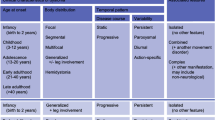Abstract
The Italian Dystonia Registry is a multicenter data collection system that will prospectively assess the phenomenology and natural history of adult-onset dystonia and will serve as a basis for future etiological, pathophysiological and therapeutic studies. In the first 6 months of activity, 20 movement disorders Italian centres have adhered to the registry and 664 patients have been recruited. Baseline historical information from this cohort provides the first general overview of adult-onset dystonia in Italy. The cohort was characterized by a lower education level than the Italian population, and most patients were employed as artisans, builders, farmers, or unskilled workers. The clinical features of our sample confirmed the peculiar characteristics of adult-onset dystonia, i.e. gender preference, peak age at onset in the sixth decade, predominance of cervical dystonia and blepharospasm over the other focal dystonias, and a tendency to spread to adjacent body parts, The sample also confirmed the association between eye symptoms and blepharospasm, whereas no clear association emerged between extracranial injury and dystonia in a body site. Adult-onset dystonia patients and the Italian population shared similar burden of arterial hypertension, type 2 diabetes, coronary heart disease, dyslipidemia, and hypothyroidism, while hyperthyroidism was more frequent in the dystonia population. Geographic stratification of the study population yielded no major difference in the most clinical and phenomenological features of dystonia. Analysis of baseline information from recruited patients indicates that the Italian Dystonia Registry may be a useful tool to capture the real world clinical practice of physicians that visit dystonia patients.



Similar content being viewed by others
Change history
18 April 2018
In the original article, Gina Ferrazzano was affiliated to Department of Neurology and Psychiatry, Neuromed Institute IRCCS, Sapienza University of Rome, Pozzilli, Italy.
The corrected affiliation should be: Neuromed Institute IRCCS, Pozzilli, IS, Italy.
References
Defazio G, Abbruzzese G, Livrea P, Berardelli A (2004) Epidemiology of primary dystonia. Lancet Neurol 3:673–678
Marsden CD (1976) The problem of adult-onset idiopathic torsion dystonia and other isolated dyskinesias in adult life (including blepharospasm, oromandibular dystonia, dystonic writer’s cramp, and torticollis, or axial dystonia). Adv Neurol 14:259–276
Albanese A, Bhatia K, Bressman SB, Delong MR, Fahn S, Fung VS, Hallett M, Jankovic J, Jinnah HA, Klein C, Lang AE, Mink JW, Teller JK (2013) Phenomenology and classification of dystonia: a consensus update. Mov Disord 28:863–873
Stamelou M, Edwards MJ, Hallett M, Bhatia KP (2012) The non-motor syndrome of primary dystonia: clinical and pathophysiological implications. Brain 135:1668–1681
Romano R, Bertolino A, Gigante A, Martino D, Livrea P, Defazio G (2014) Impaired cognitive functions in adult-onset primary cranial cervical dystonia. Parkinsonism Relat Disord 20:162–166
Berardelli I, Ferrazzano G, Pasquini M et al (2015) Clinical course of psychiatric disorders in patients with cervical dystonia. Psychiatry Res 229:583–585
Defazio G, Berardelli A, Hallett M (2007) Do primary adult-onset focal dystonias share aetiological factors? Brain 130:1183–1193
Steeves TD, Day L, Dykeman J et al (2012) The prevalence of primary dystonia: a systematic review and meta-analysis. Mov Disord 27:1789–1796
Defazio G, Gigante AF (2013) The environmental epidemiology of primary dystonia. Tremor Other Hyperkinet Mov (N Y) 3:tre-03-131-3076-1. doi:10.7916/D8QN65GQ
Klein C (2014) Genetics in dystonia. Parkinsonism Relat Disord 20(Suppl 1):S137–S142
Defazio G, Matarin M, Peckham EL et al (2009) The TOR1A polymorphism rs1182 and the risk of spread in primary blepharospasm. Mov Disord 24(4):613–616
ISTAT—Istituto Nazionale di Statistica (2011) Nomenclatura e classificazione delle Unità Professionali. http://cp2011.istat.it/
Martino D, Defazio G, Alessio G et al (2005) Relationship between eye symptoms and blepharospasm: a multicenter case–control study. Mov Disord 20:1564–1570
Aniello MS, Martino D, Masi G, Livrea P, Defazio G (2006) Sensitivity and specificity of a self-administered questionnaire for familial screening of adult-onset dystonia. Mov Disord 21:571–575
Lange F, Seer C, Salchow C et al (2016) Meta-analytical and electrophysiological evidence for executive dysfunction in primary dystonia. Cortex 82:133–146
Istituto Superiore di Sanità (2017) Progetto cuore. Epidemiologia e prevenzione delle malattie cerebro e cardiovascolari. http://www.cuore.iss.it
Madariaga G, Palacios SS, Guillén-Grima F, Galofré JC (2014) The incidence and prevalence of thyroid dysfunction in Europe: a meta-analysis. J Clin Endocrinol Metab 99(3):923–931
Defazio G, Berardelli A, Abbruzzese G et al (1998) Possible risk factors for primary adult onset dystonia: a case–control investigation by the Italian Movement Disorders Study Group. J Neurol Neurosurg Psychiatry 64:25–32
Defazio G, Gigante AF, Abbruzzese G et al (2013) Tremor in primary adult-onset dystonia: prevalence and associated clinical features. J Neurol Neurosurg Psychiatry 84:404–408
Wang L, Chen Y, Hu B, Hu X (2016) Late-onset primary dystonia in Zhejiang province of China: a service based epidemiological study. Neurol Sci 37:111–116
van Rooijen DE, Geraedts EJ, Marinus J, Jankovic J, van Hilten JJ (2011) Peripheral trauma and movement disorders: a systematic review of reported cases. J Neurol Neurosurg Psychiatry 82:892–898
Martino D, Defazio G, Abbruzzese G et al (2007) Head trauma in primary cranial dystonias: a multicentre case–control study. J Neurol Neurosurg Psychiatry 78:260–263
Nutt JG (1984) Meige syndrome and thyroid dysfunction. Neurology (suppl 1): 222
Lang AE (1985) Familial Meige syndrome and thyroid dysfunction. Neurology 35:138
Tiderington E, Goodman EM, Rosen AR et al (2013) How long does it take to diagnose cervical dystonia? J Neurol Sci 335:72–74
Macerollo A, Superbo M, Gigante AF, Livrea P, Defazio G (2015) Diagnostic delay in adult-onset dystonia: data from an Italian movement disorder center. J Clin Neurosci 22(3):608–610
Author information
Authors and Affiliations
Corresponding author
Ethics declarations
Funding
This study was not funded by any sources.
Conflict of interest
The authors declare that they have no conflict of interest.
Rights and permissions
About this article
Cite this article
Defazio, G., Esposito, M., Abbruzzese, G. et al. The Italian Dystonia Registry: rationale, design and preliminary findings. Neurol Sci 38, 819–825 (2017). https://doi.org/10.1007/s10072-017-2839-3
Received:
Accepted:
Published:
Issue Date:
DOI: https://doi.org/10.1007/s10072-017-2839-3




